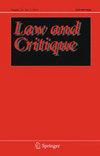法律残存与法律形式的弹性
IF 0.9
Q2 LAW
引用次数: 0
摘要
法律制度是在特定的时间点上创建的,旨在应用于“生活”,因为在特定的时刻,当它们被详细阐述并形成法律形式时,人们就会感受到它。因此,法律制度在其最初的设计中总是已经涉及某种常态,但在法律制度的创建时刻与将其应用于未来的情况之间总是存在一定的时间滞后。有些法律制度——在本文中被称为“法律遗存”——在它们被创造的时代之后仍然存在,并且在导致它们被创造的条件同时消失之后很长一段时间内继续它们的法律生命。本文的目的是对法律遗存提出一种考古谱系的观点,不仅是研究法律的连续性和法律形式的弹性的一种方法,而且是一种能够丰富我们对法律与不断变化的生活环境之间关系的理解的探索路线。对法律遗存的研究可以把法律连续性的三个方面结合起来:第一,在不同情况下为不同目的继续使用相同的法律形式,从而使相同的法律形式充满了不同的社会经济实质;第二,法律形式逐渐适应新形势;第三,新法律形式的出现与旧法律形式密切相关。对法律遗迹的研究使我们能够在法律形式的稳定性和可预测性的基础上,探讨法律主张权威的基础。它也揭示了法律形式的复杂性和层次性,法律形式实际上具有重写本的结构。本文章由计算机程序翻译,如有差异,请以英文原文为准。
Legal Survivals and the Resilience of Juridical Form
Abstract Legal institutions are created at a certain point in time, intended to be applied to ‘life’ as it is perceived at the specific moment when they are elaborated and cast into legal form. As a result, legal institutions always already refer, in their original design, to a certain normality, but between the moment of creation of a legal institution and its application to future situations there is always a certain time lag. Some legal institutions—referred to in the paper as “legal survivals” –outlive the epoch in which they were created and continue their legal life long after the conditions which lead to their creation had, in the meantime, disappeared. The aim of this paper is to put forward an archaeologico–genealogical perspective on legal survivals not only as a method of studying continuity of law and the resilience of juridical form, but also as a line of enquiry capable of enriching our understanding of the juridical in its relation to the changing circumstances of life. The study of legal survivals allows to combine three aspects of legal continuity: firstly, the continued use of the same legal forms in different circumstances and for different purposes, whereby the same juridical form is filled with different socio-economic substance; secondly, the gradual adaptation of legal forms to new circumstances; thirdly, the emergence of new legal forms in close reference to old ones. The study of legal survivals allows to address the foundations of law’s claims to authority, based on stability and predictability of juridical forms. It also reveals the complex and multilayered nature of legal form which effectively has the structure of a palimpsest.
求助全文
通过发布文献求助,成功后即可免费获取论文全文。
去求助
来源期刊

LAW AND CRITIQUE
LAW-
CiteScore
2.30
自引率
25.00%
发文量
19
期刊介绍:
Law and Critique is the prime international critical legal theory journal. It has been published for 20 years and is associated with the Critical Legal Conference. Law and Critique covers all aspects of legal theory, jurisprudence and substantive law that are approached from a critical perspective. Law and Critique has introduced into legal scholarship a variety of schools of thought, such as postmodernism; feminism; queer theory; critical race theory; literary approaches to law; psychoanalysis; law and the humanities; law and aesthetics and post-colonialism. Postmodern jurisprudence, law and aesthetics and law and psychoanalysis were pioneered in Law and Critique which remains the most authoritative international source for these schools of thought. Law and Critique is keen to translate and incorporate non-English critical legal thought. More specifically, Law and Critique encourages the submission of articles in the areas of critical legal theory and history, law and literature, law and psychoanalysis, feminist legal theory, critical race theory, law and post-colonialism; postmodern jurisprudence, law and aesthetics; legal phenomenology; and law and autopoiesis. Past special issues include: ''Critical Legal Education''; ''The Gender of Law''; ''Law and Postmodernism''; ''Law and Literature''; ''Law and Post-colonialism'', ''Law and Theatre''; ''Jean-Luc Nancy and Law''; ''Agamben and Law''. Law and Critique is ranked amongst the top 20 per cent of law journals by the Australian Research Council.
 求助内容:
求助内容: 应助结果提醒方式:
应助结果提醒方式:


